
Viva Trees
Get a FREE professional tree service estimate from Viva Trees - one of the most trusted tree companies in the U.S.
OR CALL
Get a Free Estimate
Every project starts with a free tree service estimate. Enter your details to get started.

Get a FREE professional tree service estimate from Viva Trees - one of the most trusted tree companies in the U.S.
OR CALL
Every project starts with a free tree service estimate. Enter your details to get started.
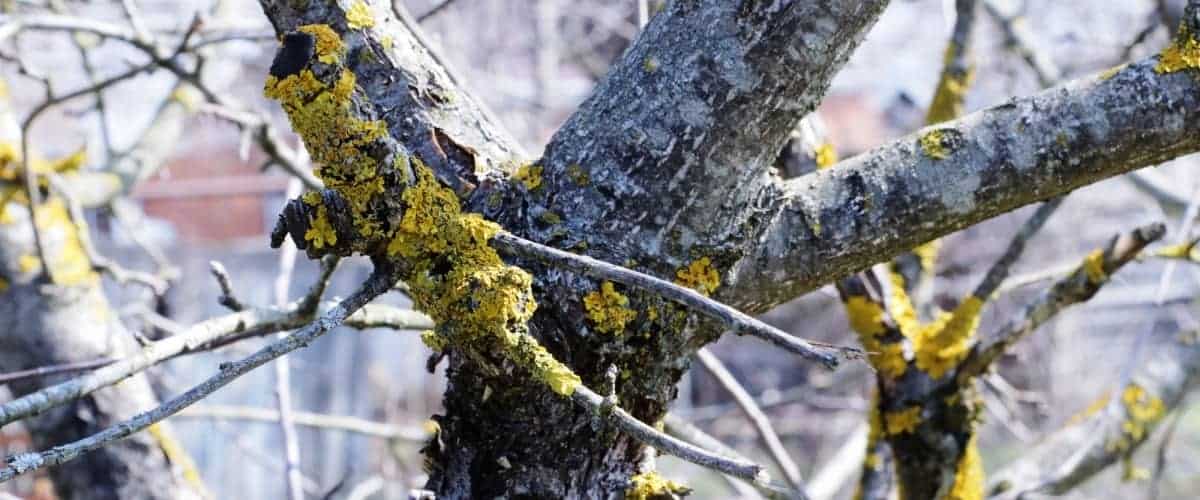
As a professional tree care specialist at Viva Trees, one of the most common questions we get from homeowners and business owners is, “How do I know if my tree is diseased or dying?”
Identifying a diseased or dying tree is important because it can help prevent the spread of disease to other trees, protect property and people from potential damage, and ensure that the tree receives the proper treatment or is removed as soon as possible.
In this Viva Tip, we’ll discuss common signs of a diseased or dying tree, other factors that can cause similar symptoms, how to properly diagnose a diseased or dying tree, and treatment options.
As a homeowner or business owner, it’s essential to recognize the signs of a diseased or dying tree.
Some common signs include:
It’s important to note that these symptoms can also be caused by other factors, such as pests, stress, or environmental conditions that we will discuss further below.
But let’s start with the first item on the list.
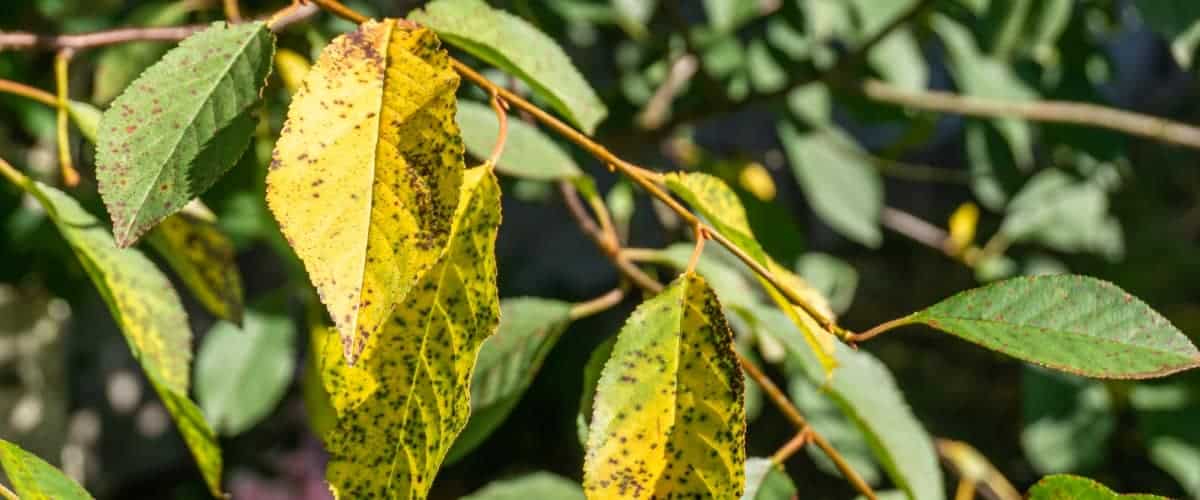
Tree leaves that are yellow or brown when they shouldn’t be or that fall off the tree too soon could be a warning sign. It may be due to disease, damage, or other causes that can risk the tree’s health.
Keeping an eye out for changes in color and timing is essential; if the leaves unexpectedly start turning yellow or become limp, it could signal an early warning of trouble.
Paying attention to timing and the tree’s overall health is essential. The discoloration may be due to the plant going into dormancy, which is very typical, depending on the season.
But it’s equally important to observe the overall condition of a tree and any changes in its behavior over time. If a tree starts to look worn down or sickly despite attempts to nurture it back to health, it can sometimes be a sign of something wrong—a hidden problem waiting to be discovered.
In these cases, seeking professional advice from arborists and gardeners can help determine what’s going on with the tree and get it on the road to recovery.
Discoloration or visible mold on the bark of trees is a tell-tale sign that something isn’t quite right. This can look like dark patches, discolorations, and abundant thick, fuzzy growth.
Also, noticing a tree with dead leaves when others do not could indicate an issue.
Pecans, live oaks, and hackberries are all tree species native to Texas that can be affected. If you have one of these trees in your yard, it’s essential to be aware because if any discoloration appears, it could be a warning sign of disease or death.
Trees are complex organisms, and we often take them for granted, but if we want to keep them healthy and part of our natural environment, we must recognize even the most minor signs of growth and bark health changes.
Taking action early when something seems wrong with a tree allows us to turn around the consequences before they become any worse, thus helping us to preserve their beauty.
Sunken spots and regions in the tree’s trunk or branches are warning signs that something is wrong. It’s a defense system of the tree, trying to prevent the spread of disease. These spots may be big or small and can appear on trunks and branches.
In Texas, sick trees from native species like pines, elms, and maples often have these symptoms. A diseased or dying tree can no longer support or protect its leaves from further harm. That’s why it’s essential to identify these signs before they worsen so appropriate steps can be taken to strengthen the tree again and guard it against future illnesses.
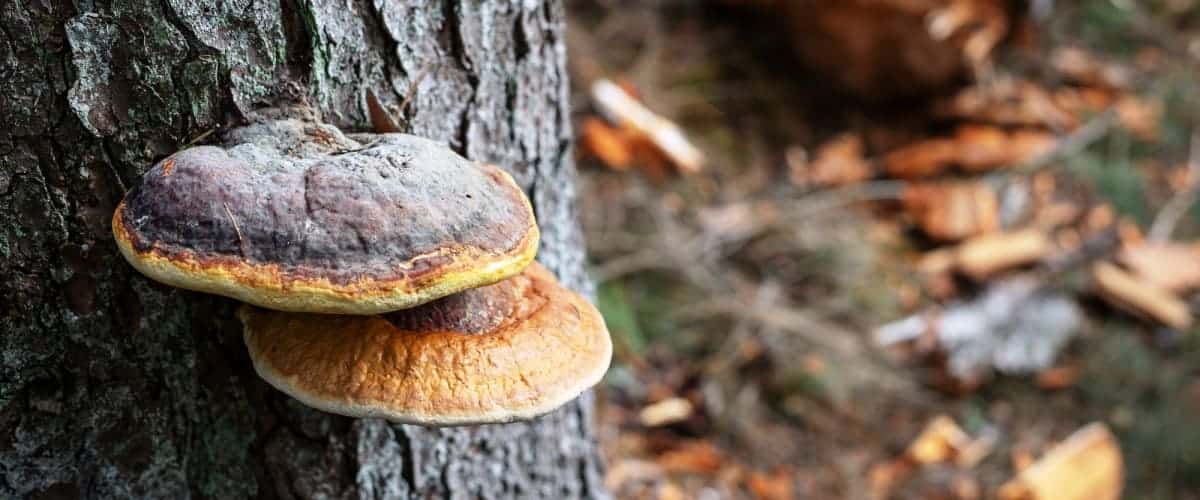
Mushrooms or other fungi growing around the bottom of a tree is a tell-tale sign that something is incorrect. These fungi only grow when there is an environment suitable for their growth, which can be caused by the tree beginning to break down.
When it comes to trees native to Texas, pines, elms, and maples are some species that might be affected by this issue.
The problem could be a fungal infection, damaged root systems, or something else entirely.
Therefore, if you spot mushrooms at the base of your tree, you may need to take appropriate action before it’s too late.
Wilting or drooping branches can be symptomatic of a diseased or dying tree. Staying aware of your tree’s health is essential to avoid missing critical signs of threatening issues.
Often, these changes can result from the tree not getting enough water or nutrients.
In Texas, some trees that may experience this symptom include pecans, live oaks, and hackberry species. Keeping a keen eye on your trees and noticing changes in their behavior is crucial for their care.
It’s equally important to give your trees the proper environment to thrive and ensure they have enough water and nutrition. Doing so will provide a lush and vibrant garden for years ahead!
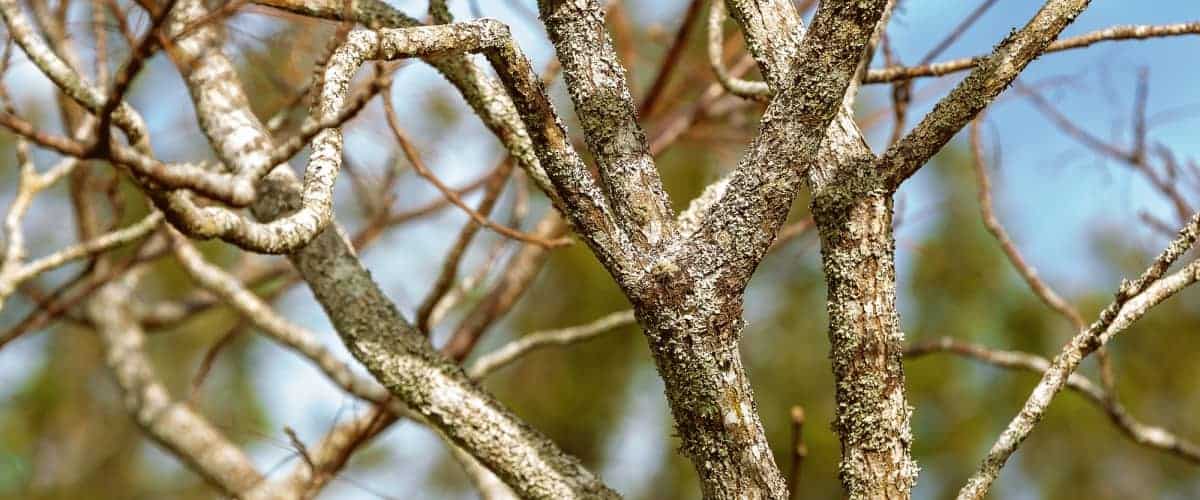
Dead or missing branches can show that a tree is somehow damaged. This may be due to pests, disease, or environmental stress.
Dead branches signify that a tree is in decline and may need removal.
If you notice missing branches, try to find them on the ground so that you may show them to your tree care professional.
In Texas specifically, some native species that people might notice this with are pines, elms, and maples.
For trees that seem unhealthy, it’s essential to take action and get the help you need, whether it’s from a tree specialist or an experienced landscaper.
Early diagnosis can save trees from further decline and give them a second chance at health.
Pruning away dead wood and conducting regular pest management efforts can also go a long way toward keeping backyard trees healthy for years and preventing them from becoming hazardous.
When trees fail for no reason, don’t wait—act fast!
Cracks and splits in a tree trunk can be signs of severe illnesses in the tree caused by pests, disease, or environmental stress. Some Texas trees that can suffer from cracks and splits are pecan, Live Oaks, and Hackberries.
The damage done by pests such as caterpillars, beetles, and grubs can weaken trees if they are not caught quickly enough. The disease can spread rapidly amongst certain species if not handled early on.
Lastly, trees planted in unforgiving environments may struggle to survive and become stressed.
Taking proactive steps like eyeing for evidence of any sickness or pest damage is essential for stopping things from getting worse. Proper nutrition and watering help keep even the most challenged tree alive for many years.
Unexpected growth patterns, such as a leaning trunk, can signify an unhealthy or dying tree. The cause may be structural weaknesses in the tree, such as disease or pests. Popular species native to Texas that could suffer in this manner include Pines, Elms, and Maples.
The presence of pests like bark beetles can lead to weakened branches and uneven growth. Similarly, diseases like Dutch Elm Disease or Hypoxylon Canker can damage a tree’s trunk, roots, and branches and make it unstable.
It is essential to monitor any sudden changes in the shape of your trees, as they could signify underlying issues that need to be addressed before further damage occurs. Professional assessments are vital to ensuring your trees stay healthy for many years.
A lack of vitality in one tree compared to other trees could indicate a diseased or dying tree. This can be caused by various problems such as pests, disease, and environmental stress. Common examples of native Texas tree species with this issue are pecan, live oak, and hackberry trees.
Trees require proper care and the environment to stay healthy. Therefore, regularly assessing any tree diseases or signs of ill health is essential.
Regular pruning and trimming should occur at the correct times of the year, and fertilization should also be done by the needs of each species.
If a tree does not respond positively after proper care is taken, further investigation should be conducted to diagnose the problem correctly.
Several factors, including pests, environmental stress such as drought or poor soil conditions, cultural practices such as pruning and fertilization, and natural aging, may cause the mentioned symptoms.
For instance, the Emerald Ash Borer and the Texas Ash Borer can severely damage ash trees, while mismanagement of water and fertilizer can lead to tree stress.
Therefore, determining the cause behind any symptom is integral to successfully diagnosing a tree’s health problem.
A comprehensive evaluation that considers current and past conditions is needed to understand what’s going on with a tree.
In addition to examining the individual tree itself, it helps to look at surrounding trees in the area for comparison.
Using this holistic approach, you can get to the root cause more quickly than simply treating an isolated symptom.
Let’s look closely at other factors that can cause similar symptoms.
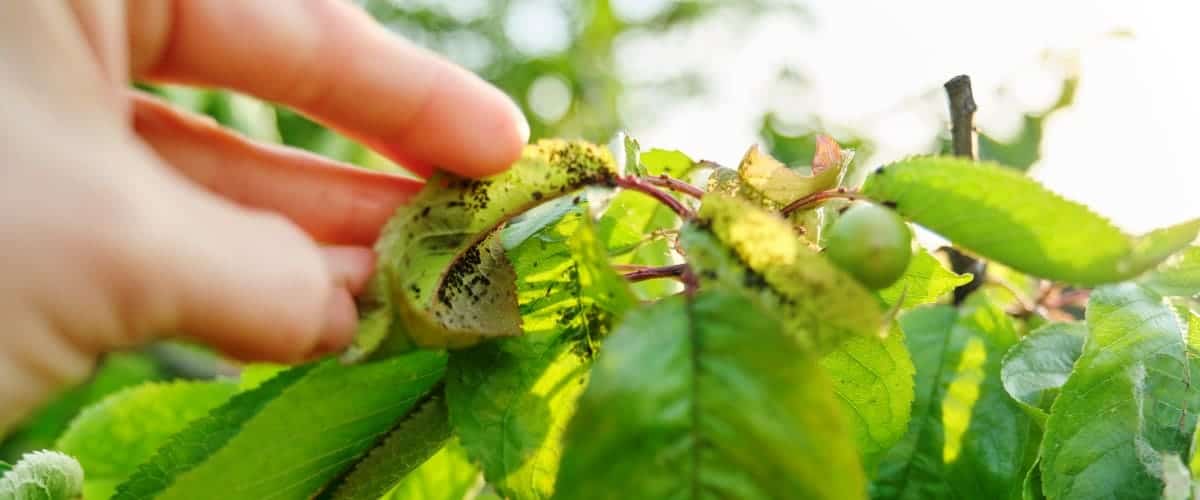
Pest damage can often lead to the same symptoms as an ill or dying tree. Native Texas trees are especially vulnerable to pests such as Emerald Ash Borer and Texas Ash Borer, damaging ash trees, while the Cotton Root Rot fungus affects many tree species.
These pests can spread illnesses, create weakened parts of the tree, and weaken its structure in general. Furthermore, they negatively affect the health of the soil beneath it.
When confronted with an infestation, swift action must be taken to contain them before they cause significant damage. If left unchecked, pests can bore into trunks and make it easy picking for even more predators to come in.
The only course of action is proper pest control using safe methods to keep your trees healthy and from further harm.
Environmental stress can wreak havoc on trees, both young and old. Drought and poor soil conditions can cause a tree to suffer from wilting or discolored leaves – a sign of an unhealthy, stressed tree.
Addressing environmental stress before it gets out of hand proactively is essential. Regular watering and soil care are necessary for maintaining good health in any tree.
These simple preventative practices will help ensure that your tree keeps vibrancy and longevity.
In some cases, drought or other environmental conditions may necessitate professional assistance, and additional measures may be taken to protect your tree from further damage. Keeping a close eye is essential if you sense extreme environmental stress setting in.
Our trees suffer the same ailments as any living species without proper nourishment and care. Taking the proper steps to avoid environmental stress will preserve the health of your beloved trees long into the future.
Cultural practices, such as improper pruning or fertilization, can cause similar symptoms to those of a diseased or dying tree. Pruning correctly can lead to more robust structures, and fertilizer wrongly applied can contribute to nutrient deficiencies.
For optimal growth, it’s essential to employ specific pruning and fertilizing strategies for each tree species. Trees that are adequately nurtured with the proper care and attention will grow strong and healthy year-round.
Poorly executed cultural practices negatively affect short-term tree health and undermine trees’ long-term value and enjoyment in your landscape.
Also, unhealthy trees are more prone to pest infestations, further weakening the protected status of these vital resources within an urban context.
Having reliable facts about proper pruning and fertilization is essential for improving private and public landscapes to create healthier environments for people, plants, and animals.
Aging trees can present a range of signs and symptoms that may have nothing to do with infestations or disease. The leaves on an aging tree may fade in color and become brittle or discolored.
The bark on the tree may start to flake away, as well as reveal streaks of discolorations reaching out from the center of the trunk.
Branches may begin dying off without explanation, showing no signs of the fungus spreading from one branch to another.
Logs and stumps from old trees can also reveal evidence of rotting wood due to natural aging, presenting symptoms such as indentations in the wood, discoloration, and patches of wetness.
All these factors must be considered when examining a potentially dying tree and ruling out natural causes before attempting treatments.
A professional arborist is best qualified to properly diagnose a diseased or dying tree. Before consulting one, observe any symptoms, the tree species, and recent environmental changes. Critical data on soil moisture, water levels, and nutrient inputs can also be helpful information.
Following data collection, an arborist will evaluate the situation, inspecting bark, leaves, roots, and other foliage to determine the cause of the decline. Sometimes, this may involve taking a core sample or sending samples off for laboratory testing.
Once a diagnosis is made, possible solutions such as fertilizing, aerating, or chemical treatments can be discussed with the arborist. With their experience and expertise, they can advise on treatment options that will best provide the tree with lasting health benefits.
Consulting with an arborist is essential to ensure the health and longevity of trees. They are knowledgeable professionals who understand the needs of trees and can provide expert guidance on how to best care for them.
From diagnosing a diseased or dying tree to deciding whether a tree needs to be pruned or removed, arborists offer valuable insights that would otherwise be difficult to obtain.
A well-maintained and healthy tree can provide many benefits, such as shade from the sun in summer months, shelter from wind and rain, habitat for birds and other wildlife, and help improve air quality by filtering pollutants.
Working with a professional tree service will help protect and preserve these critical ecological elements in urban areas.
For the safety of people and trees, properly trained arborists should always be consulted before making any impactful decisions about managing a tree’s health.
It’s essential to prepare for a consultation with an arborist properly.
Beforehand, observe the tree species, document any symptoms, and take pictures of the tree and any issues you’ve spotted.
Also, note down any recent changes to the environment surrounding the tree. This information will help the arborist get an accurate diagnosis quickly and easily.
Remember: Preparing ahead will undoubtedly pay off to determine the best possible solution for your tree!
An arborist is an expert in diagnosing a diseased or dying tree. They use their knowledge of plants to observe the tree and identify its symptoms.
Each tree species responds differently to illness and environmental changes, so they must consider this when investigating a possible case.
In addition to observation, an arborist may take samples of the sick tree and send them off for further analysis by a plant pathologist.
This allows them to obtain more detailed information about the cause of the problem and determine the most appropriate steps they can take to help revive it.
Understanding the cause of a diseased or dying tree requires more than just an arborist’s assessment. As mentioned above, other professionals, such as plant pathologists, can provide critical insight into diagnosis and treatment.
Plant pathologists specialize in common tree diseases, with the ability to inspect soil or tissue samples from a different scientific perspective, leading to a better understanding of the disruption that caused the tree’s death.
Getting an accurate diagnosis is critical when treating a diseased or dying tree. This way, proper action can be taken that fits each case.
A treated tree may have options for prescription medicines, natural treatments, and cultural practices which rely on environment optimization.
And if the tree needs to be removed, the right kind of removal service should be carried out to ensure there isn’t any further damage to other trees in the area. I’ll provide a few tips in the following sections.
It’s good practice to do everything possible to save a diseased or dying tree while adhering to safety protocols and understanding the likely outcomes.
But when removing the diseased or dying tree becomes more cost-effective or safe, this should be considered seriously with the help of knowledgeable professionals.
When a tree needs help but is still salvageable, the options become clear: insecticide and fungicide treatments, pruning, and fertilization.
By bringing these treatments together, your arborist can assess the tree’s overall health and customize a program that meets its individual needs.
This could be as simple as routine trimming to keep growth from interfering with adjacent buildings or complex chemical treatments to combat severely contaminated soil.
The results depend on the proper application of materials and timing for when it is most effective and beneficial for the tree.
Careful examination of a struggling tree will guide the treatment plan depending on its state of health, such as:
Ultimately, these treatments are designed to restore life and hope in an old friend while preserving beauty in our surroundings.
Removing a dead tree or one that cannot be saved requires proper precautions. Two of the most common options for tree removal are traditional methods and stump grinding.
When using traditional methods, safety is vital. This typically involves sawing, wedge insertion, and controlling the direction of the tree fall. It’s also important to assess any potential risks from nearby structures or power lines before attempting this removal.
Stump grinding is another option for removing a tree beyond repair. This eliminates the need for sawing and physically removing large timber from the area.
The result is ground-level soil that can easily be used as planting space or further landscaping development. Regardless of which method you choose, make sure to exercise extreme caution during both types of procedures.
Following proper safety procedures when treating or removing a diseased or dead tree, such as wearing protective clothing and using the correct tools, is essential.
Failing to do so puts you at risk of hurting or damaging your property.
Before doing any work, you should always inspect the area surrounding the tree, ensure no one is in the immediate vicinity, and plan out all steps needed during removal.
It is also essential to ensure your ladder is on even ground with nothing blocking its feet — like rocks — and adequately secured before climbing.
When using tools like a saw or axe, make sure they are sharp to be used safely and efficiently.
Always treat the diseased or dying tree with respect, use caution when handling it, and don’t overlook any potential hazards when working around it.
In conclusion, identifying a diseased or dying tree is essential to protect property and people, prevent the spread of disease to other trees, and ensure that the tree receives the proper treatment or removal as soon as possible.
By understanding the common signs of a diseased or dying tree, other factors that can cause similar symptoms, how to properly diagnose it, and treatment options, homeowners and business owners can take action to protect their trees.
If you have any concerns about the health of your trees, don’t hesitate to contact the professionals at Viva Trees. We’re here to help you keep your trees healthy and beautiful.
If you liked this blog, check out our other tree care and maintenance articles on: